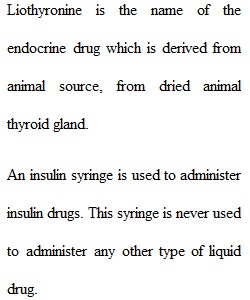


Q 1. Name some endocrine drugs that are derived from animal sources. 2. List some of the differences between type 1 and type 2 diabetes mellitus. 3. How are doses of insulin measured? 4. Name two ways that insulin is administered. 5. Oral antidiabetic drugs contain a special type of insulin that can be taken orally. True or False? 6. Why were beef and beef/pork insulin removed from the market? 7. List some of the generic and trade names for insulin drugs that are produced using recombinant DNA technology. 8. Why are oral antidiabetic drugs not given to patients with type 1 diabetes mellitus? 9. Name several categories of oral antidiabetic drugs and describe their therapeutic effects in treating diabetes mellitus. 10. List four trade names of drugs used to treat hypothyroidism. 11. What type of drug is used to treat children with failure to grow? To treat adults with acromegaly? 12. Describe some of the physical changes that occur in a patient who takes a prolonged or high dose of a corticosteroid drug. 13. Describe the therapeutic effect of the legal use of anabolic steroid drugs and the detrimental side effects of the illegal use of anabolic steroid drugs. 14. Match the following generic drug endings to their correct drug category. a. –amide/ –ride/ –zide b. –gliflozin c. –glinide d. –gliptin e. –glitazone f. –asone/ –isone / –olone g. –sterone _____ generic thiazolidinedione oral antidiabetic drugs _____ generic corticosteroid drugs _____ generic SGLT2 inhibitor oral antidiabetic drugs _____ generic androgen hormone drugs _____ generic sulfonylurea oral antidiabetic drugs _____ generic meglitinide oral antidiabetic drugs _____ generic DDP-4 inhibitor oral antidiabetic drugs
View Related Questions